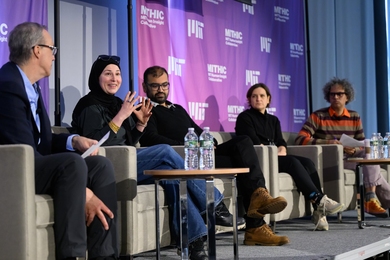President Charles M. Vest fielded questions on the status of reengineering at MIT, the SAP system and the election of Alexander V. d'Arbeloff as chairman of the Corporation at a town meeting last week in the Sloan School's Tang Center.
When asked if he was comfortable discussing possible layoffs, Dr. Vest replied candidly, "No. But I will."
While noting that about 160 positions on campus had already been eliminated through reengineering and the retirement incentive program alone, he told an audience of faculty, administration, staff and students in the Wong Auditorium that in order to achieve the desired savings in the operating budget, further reductions would be necessary. He said the original goal of reducing the annual budget by $40 million would require a reduction of about 400 positions.
Dr. Vest said it is hard to translate the reduction in work saved through new processes into meaningful savings when these processes reflect only a part of an individual's overall workload. The administration will be working with departments to estimate savings that might be achieved with the use of new tools and streamlined procedures. Some future staff reductions may be accomplished through attrition, Dr. Vest said, but in some cases, "layoffs might be required."
An audience member who described himself as a recent retiree asked Dr. Vest to comment on a recent Wall Street Journal article that questioned the success of reengineering in business.
Noting the difference in goals between higher education and private industry, Dr. Vest said he had misgivings about using the term reengineering to describe the activities at MIT. Nonetheless, a strategy had to be formulated to reduce costs while maintaining excellence. "It seemed like an MIT thing to do," he said. "We figure out how to take something apart and put it together in a way that is simpler and better."
The questioner also wondered why a campaign to attract more undergraduates had not been part of the plan. Dr. Vest replied that support for such an approach would not be well received unless the Institute had proved it could be more "efficient, effective and lean."
Asked what role the faculty could play in the reengineering process, Dr. Vest noted that business leaders question the productivity of academics. He urged the faculty to "think holistically" about how the Institute works.
"We do need to broadly involve the faculty in the change process," Dr. Vest said. He cited several examples of how faculty are already involved, on both the organizational and academic fronts: the Task Force on Student Life and Learning and the four Institute councils on the environment, educational technologies, relations with industry and international institutional relations.
Noting that the activities now underway should be completed by the end of 1998, Dr. Vest said MIT needs to think afterwards about how to continue to improve operations in a way that engages even more people around the Institute. He added that he was pleased that reengineering had unleashed many good ideas and energy among employees and had developed a network of people who have the potential to become the Institute's "leaders for the future."
SAP, BUILDING DISCUSSED
Turning to the new SAP financial-record system, Dr. Vest acknowledged that it had to be adapted to fulfill MIT's needs and promised that problems would be confronted and solved.
"Believe it or not," he said, "I'm learning to use SAP myself."
Someone wondered who was training the president.
"I took some poetic license," Dr. Vest said. "I should have said I promised to learn it."
A woman in the audience asked how the Institute could build an $18 million athletic facility in the midst of severe belt-tightening. Dr. Vest noted the importance of maintaining and renewing the physical plant for the benefit of future generations of students and faculty, noting that there had been a strong need for a new athletic facility-and particularly a pool-for decades. The opportunity to move ahead on this project came when Barrie and Albert Zesiger (SB '51) pledged 40 percent of the construction costs and offered to help raise the rest.
Dr. Vest said this project is an excellent example of having a vision for the Institute. "Belief in the future lets you do things like this," he said.
Dr. Vest said he was "very enthused" about the election of Mr. d'Arbeloff as the next chairman of the Corporation. "I have personally turned to him a number of times for his wisdom," he said.
A version of this article appeared in MIT Tech Talk on December 18, 1996.





